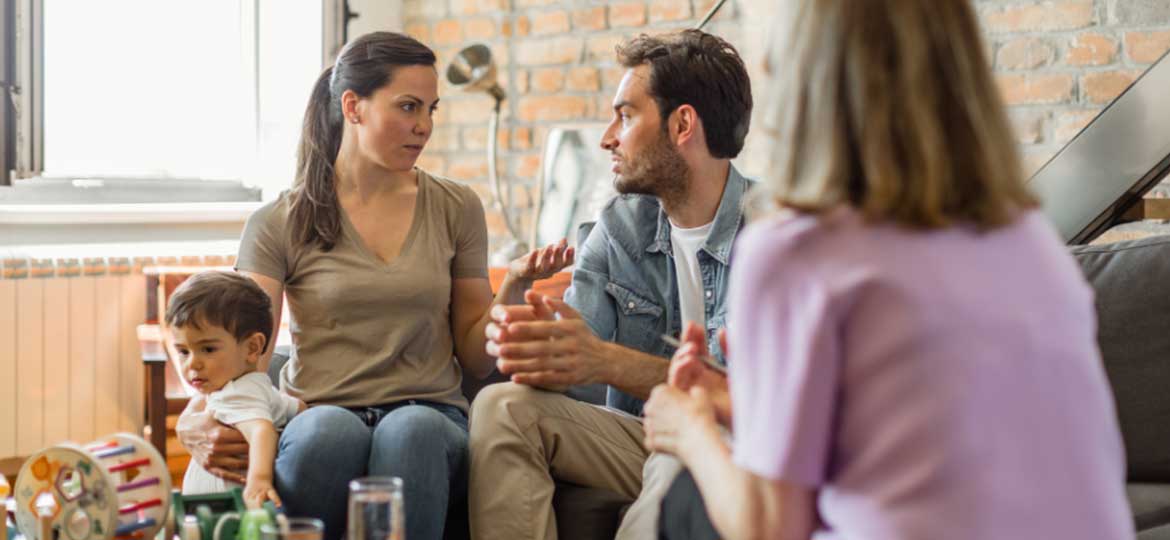Calgary Family Counselling and Therapy: Healing and Empowering Families

At our Calgary Psychologist Clinic, we understand that family is the cornerstone of our lives, and nurturing healthy family dynamics is essential for the well-being of every member. Whether you’re facing conflicts, transitions, or challenges as a family, our dedicated team of therapists specializes in family counselling, providing you and your loved ones with the support and guidance you need to thrive.
Fostering Harmony and Understanding
Families come in all shapes and sizes, and no two are alike. Family counselling is all about strengthening the communication and understanding between family members, fostering a deeper connection, and promoting harmony within the household. Our therapists work collaboratively with you and your family to identify underlying issues, address conflicts, and develop effective strategies for resolving disputes and improving relationships.
Our Family Therapists, Psychologists and Counsellors
Dr. Raheleh Tarani
Registered Provisional Psychologist
English, Farsi, Japanese (basic), Hindi, Turkish, Punjabi, Urdu
Murray Molohon
Registered Psychologist
English
Jarret Verwimp
Clinical Canadian Certified Counsellor
English, French, Spanish (basic)
Nav Gill
Registered Provisional Psychologist / Clinical Counsellor
English, Punjabi
Andrea Krygier
Registered Psychologist
English, Spanish
Navigating Transitions with Grace
Life is full of transitions, from welcoming a new baby to adjusting to changes in family structure or dynamics. These transitions can sometimes bring about stress, tension, and uncertainty within the family unit. Family counselling provides you with the tools and support you need to navigate these transitions with grace and resilience. Whether you’re blending families, navigating divorce, or adjusting to a new family dynamic, our therapists will help you navigate the challenges and find common ground as a family.
Understanding Each Other's Perspectives
One of the core principles of family counselling is recognizing and understanding the different narratives that each family member holds. These narratives shape our understanding of ourselves and others, influencing our perceptions and behaviors within the family unit. Our therapists will help you and your family members explore these narratives, identify patterns of interaction, and gain insight into each other’s perspectives. By fostering empathy and understanding, we can promote healthier communication and stronger relationships within the family.
Building Stronger Bonds
At the heart of family counselling is the belief that every family has the potential to thrive. Through guided exercises, discussions, and activities, our therapists will help you and your family members build stronger bonds, deepen your connection, and create a more supportive and nurturing environment for everyone. Whether you’re seeking support for parenting challenges, sibling conflicts, or generational differences, we’re here to help you and your family navigate these issues with compassion and understanding.
Take the First Step Towards Family Harmony
Ready to invest in the health and happiness of your family? We’re here to help. Contact us today to schedule your free consultation and take the first step towards building stronger, more resilient family relationships. At Best Choice Counselling & Assessments, we’re committed to helping your family thrive, one session at a time.
Family Therapy Interventions: What Research Shows About Healing Relationships

Research shows amazing results for family therapy across many studies. The therapy offers the most important benefits when treating relationship problems, mood disorders, anxiety, and substance use disorders. A detailed 2018 review confirmed that family therapy helps solve adult-focused problems. The therapy also improved family functioning for teenagers with mental health challenges, according to a 2019 study.
Family therapy started in the 1950s and has grown into a well-laid-out form of psychotherapy that helps improve interactions between family members. The therapy works especially well to treat conduct problems, emotional issues, eating disorders, and recovery from abuse or neglect. It also delivers better results than individual or group approaches when treating teenage substance use disorders.
Family Systems Therapy Foundations
Murray Bowen’s family systems therapy sees families as complex emotional units where members shape each other’s thoughts, feelings, and actions [1]. This connected viewpoint creates the foundation to understand family dynamics and therapeutic interventions.
Basic Principles and Concepts
Family systems therapy works on a simple truth – changes in one family member affect everyone else [1]. Families develop emotional bonds that help them stay together. These supportive connections can become stressful when tension rises. Family members pass anxiety to each other when stress levels go up, which makes emotional bonds feel more like a burden than comfort [1].
Role of the Family Therapist
Family therapists play several key roles in therapy. Their main responsibilities are to:
Build trust and promote communication
Clear up conflicts and remove barriers
Help test reality
Push, challenge, and teach family members [2]
Therapists need to stay objective even when family systems try to pull them into existing patterns [3]. Their approach changes based on their theoretical background – from Satir’s warm, supportive style to Bowen’s more objective, separate stance [3].
Therapeutic Alliance Building
Building relationships in family therapy needs different skills than individual therapy. Therapists must create bonds with each family member, various groups within the family, and the whole family at once [3]. Research shows stronger therapeutic relationships associate with better outcomes, showing an effect size of d=.622 [4].
Therapeutic relationships let therapists and family members connect in meaningful ways that can fix old patterns [3]. Success comes from staying neutral, creating safe spaces during sessions, and fixing relationship problems quickly to keep families in treatment [4].
Understanding Family Therapy Approaches
Family therapy began in the late 1950s, with practitioners emerging at the same time in different parts of the United States and United Kingdom [5]. This therapeutic approach brought a major transformation in how professionals understood and treated relational problems, rather than focusing only on individual psychopathology [6].
Rise of Family Systems Theory
The fields of biology and cybernetics gave birth to family systems theory in the 1940s and 1950s [5]. Early family therapists took von Bertalanffy’s ideas and applied them to family systems. They introduced concepts like equifinality, morphostasis, and morphogenesis [5]. Gregory Bateson, a British anthropologist, left his mark on the field by bringing systems theory into couple and family therapy [5].
Key Theoretical Models and Frameworks
Modern family therapy practice draws from several distinct theoretical models:
Structural Family Therapy: Focuses on family organization, hierarchy, and boundary clarity [7]
Strategic Family Therapy: Emphasizes problem-solving and specific intervention strategies [8]
Narrative Family Therapy: Centers on rewriting family narratives in empowering ways [7]
Solution-Focused Family Therapy: Concentrates on future goals rather than past problems [9]
Modern Adaptations in Family Therapy
Family therapy has grown to meet the needs of people from different cultures and backgrounds. Cultural factors play a big role in how well therapy works [6]. Modern approaches now include psychoeducational elements that give families information about mental health issues and coping strategies [9].
The reach of family therapy goes beyond traditional settings. Systems-based approaches have shown improved results in treating various challenges, including substance use disorders [10]. Brief counseling methods that focus on current family issues and cognitive-behavioral changes have become part of the field [10].
New theoretical viewpoints have enriched family therapy practice. Therapists now look at how family members’ beliefs affect their interactions and how cultural forces shape these beliefs [5]. These changes show that we need to see family systems as part of their broader social and cultural environment.
Evidence-Based Family Therapy Interventions
Research shows that family therapy works well in clinical settings of all types and with different groups of people. Studies prove that family-based treatments reduce adolescent substance use and make families work better together [11].
Research-Supported Treatment Models
Brief Strategic Family Therapy (BSFT) has proven itself as a reliable way to help young people with behavior problems. The research backs this up – BSFT helps reduce bad behavior, cuts down time spent with troublesome friends, and strengthens family bonds [12]. Family Therapy based on Attachment (ABFT) has earned its place on many national and international lists of proven treatments [13].
Basic family therapy methods used in regular behavioral treatment create big improvements in how patients do. Research shows that using these methods more often helps reduce teenage delinquency and problem behaviors a year later [11].
Outcome Studies and Effectiveness
Studies show that sticking to family therapy guidelines associates with better results [11]. Research on family programs shows several benefits:
Fewer trips to emergency rooms and hospital stays
Lower chances of relapse and psychotic symptoms
Better treatment completion rates
Better family communication
Family participation in treatment helps boost attendance and keeps more people in outpatient programs [2]. Kids stick with their treatment more often if their caregivers take part too [2].
Implementation Considerations
The EPIS framework (Exploration, Preparation, Implementation, and Sustainment) gives us a clear path to bring family programs into clinical settings [14]. This approach looks at external factors like service environment and organizational relationships, plus internal elements such as agency culture and staff qualities.
Implementation science helps make sure evidence-based family programs stick around [14]. A successful program needs the right space, good referral systems, trained staff, and support from the organization [14].
Studies tell us that following family therapy guidelines helps keep families involved, improves how they function, and reduces substance use in teenagers [12]. Organizations often face barriers that make it hard to involve families and caregivers in clinical treatments [15].
Specific Family Therapy Interventions
Studies show that almost 90% of people see better emotional health after going through family therapy [16]. Family therapy helps build stronger relationships and uses specific techniques to tackle different family challenges.
Crisis Intervention Techniques
A safety check is the foundation of crisis intervention in family therapy. Therapists first need to know if the situation is safe enough to step in and help [17]. They use well-laid-out methods to calm tensions and bring stability quickly during crisis moments. This approach targets behavior patterns instead of mental health issues directly because it works better in crisis situations [17].
Behavioral Change Strategies
Family therapy changes interaction patterns through structured methods. These strategies include:
Making behavioral contracts with clear goals and outcomes
Using positive reinforcement methods
Setting clear boundaries and expectations
Building problem-solving frameworks
Giving homework to practice new skills
Behavioral contracts work really well because they make everyone accountable and help family members work together [18]. These agreements spell out expected behaviors, goals, and rewards to create positive changes.
Emotional Processing Methods
Emotional regulation is the life-blood of family therapy interventions [19]. Therapists help families spot emotional triggers and build healthier responses. They create a judgment-free space where everyone can share their thoughts and feelings openly.
Attachment-based work helps strengthen emotional bonds between family members [20]. Therapists use hands-on techniques to help families better handle emotions and talk to each other. This method really shines when fixing and building stronger emotional bonds between parents and children [20].
Family therapists switch between looking at past events and current patterns to boost emotional processing [3]. The therapy moves step by step from finding unhealthy patterns to building more secure relationships through direct work with parents and children [20]. This approach helps families solve problems better and improve how they communicate with each other [3].
Assessment and Treatment Planning
A detailed family assessment serves as the life-blood of therapeutic interventions that provides a well-laid-out framework to understand family dynamics and needs. The assessment process usually takes 3-5 sessions, and each session runs for 45-60 minutes [3].
Detailed Family Assessment Tools
The North Carolina Family Assessment Scale (NCFAS) has proven itself as a verified tool to assess family functioning in multiple areas [4]. This tool covers 70 subscales in 10 domains and needs about 30-40 minutes to enter data [4]. Practitioners assess these key areas:
Physical development and health
Cognitive development
Communication and language
Social-emotional functioning
Adaptive development skills
Goal Setting and Treatment Objectives
Treatment objectives come from a formal agreement between the therapist and family members [3]. Therapists share their understanding of family dynamics positively without criticism [3]. The therapeutic team identifies minimum effective treatment plans and thinks about the most feasible changes families can make [3].
Creating Individualized Intervention Plans
A detailed systemic analysis with three generations of family history leads to individualized intervention plans [3]. The formal agreement specifies parameters like session frequency and intensity, which change based on family’s distress levels and location [3].
Treatment plans target major factors that affect safety, permanency, and child’s well-being over time [21]. The detailed family assessment looks at why issues happen, not just the visible symptoms [21]. These assessments help practitioners focus on elements they can change through targeted interventions [21].
The values that guide individualized treatment planning include cultural grounding, family system dynamics, and tailored approaches [1]. Successful implementation needs both outer context factors like service environment and inner context elements such as agency culture [21].
Families play a vital role throughout the assessment and planning process, which encourages better communication between the agency and family members [21]. This shared approach determines needed changes, services, and expectations for everyone involved [21]. Family meetings work well to encourage ongoing participation in both original and follow-up assessments [21].
Addressing Common Family Challenges
Family relationships break down when conflicts remain unresolved and communication problems build up over time. We focus on solving these problems through structured interventions and proven techniques.
Communication Breakdown Interventions
Communication patterns shape how families connect and relate to each other. Research shows that developmental changes and life stressors often lead to communication breakdowns [22]. Family therapists use specific methods to help:
Active listening techniques to boost understanding
Structured dialog sessions that express emotions
Non-verbal communication awareness training
Emotional regulation skill development
Conflict Resolution Techniques
Family therapy uses a step-by-step way to encourage healthier interactions. Research proves that unresolved conflict creates distance between family members and leads to anger, anxiety, and depression [23]. Therapists guide families through several key steps.
Families learn to focus on problems instead of people. This moves attention away from blame. Therapists teach empathic listening skills that help members understand different points of view without interruption. Families also develop emotional regulation strategies to stay calm during disagreements [24].
Trust Building Exercises
Trust creates the foundations of healthy family relationships, not surface-level interactions. Family therapists use many trust-building activities to deepen bonds between members [25]. These exercises include:
Role reversal activities that develop empathy
Guided trust walks that build confidence
Collaborative problem-solving tasks
Family gratitude journaling
Structured family meetings
Research shows that families who regularly participate in trust-building activities become stronger and more connected [26]. These exercises help create safe spaces where members feel comfortable sharing their thoughts and emotions openly [27].
Family therapists adapt these methods based on each family’s unique dynamics and challenges. Families develop practical skills through structured activities and guided practice to address conflicts and strengthen relationships [16]. These interventions work together to create lasting positive changes in how families function.
Core Family Therapy Techniques
Successful family therapy interventions rely on proven therapeutic techniques. Studies show that well-laid-out communication methods, family restructuring, and resilience building lead to lasting improvements in family relationships [5].
Communication Enhancement Strategies
Family therapy builds on active listening and reflective speaking as its core techniques. These methods teach family members to:
Verify feelings and viewpoints
Paraphrase messages before responding
Focus on nonverbal cues
Practice emotional awareness
Therapists demonstrate these behaviors during sessions so families can apply them in their daily lives [5]. Genogram construction helps reveal patterns of behavior that influence communication [28].
Restructuring Family Dynamics
Structural mapping is a vital technique that helps understand and modify family hierarchies. This method creates visual representations of family boundaries and power dynamics [29]. Therapists can spot areas that need change and guide families toward healthier patterns through this process.
Strategic interventions help reorganize family systems with specific tasks that change interaction patterns. These interventions often create quick shifts in family dynamics [28]. Clear roles and responsibilities within the family unit emerge through boundary setting techniques [29].
Building Family Resilience
Family resilience grows through strength identification and improved coping strategies. A structured “strengths family tree” exercise helps families become more self-aware and creates positive change [30]. Families learn to utilize their existing capabilities while developing new ones.
Rejuvenation activities and positive emotions play key roles in building resilience [30]. Regular family rituals and shared activities create stronger bonds and opportunities for positive interactions [5]. On top of that, solution-focused approaches help families foresee desired outcomes and develop practical steps to achieve their goals.
Each family’s unique circumstances shape how these core techniques work. Therapists adapt their methods based on cultural factors, family makeup, and specific challenges [31]. Families develop stronger communication patterns, clearer boundaries, and better problem-solving skills through these techniques [5].
Measuring Treatment Success
Measuring therapeutic outcomes is a vital part to verify family therapy works. Research shows that tracking client progress through standardized rating scales helps improve outcomes. This improvement shows up especially in clients who might fail treatment [32].
Outcome Measurement Tools
Several proven instruments help measure family therapy outcomes. The Systemic Clinical Outcome and Routine Evaluation (SCORE) provides a reliable way to track therapeutic changes [33]. Families can complete this self-report measure in about 10 minutes. It helps them share their perspective on how things are working [34].
The Family Assessment Device (FAD) reviews seven key aspects:
Problem-solving capabilities
Communication patterns
Role definition
Affective responsiveness
Affective involvement
Behavioral control
General functioning [35]
Progress Monitoring Methods
Recent evidence shows that all but one of these therapists track progress every 1-2 sessions – just 5.2% do [32]. Therapists who track changes in family dynamics can adjust their approach based on what they see. Session-by-session progress data helps therapists make better clinical decisions [32].
Time limits, paperwork, and resource constraints often get in the way of regular monitoring [32]. Digital platforms make it easier to give and score assessments more often [36]. Successful monitoring happens when therapists set clear treatment plans, focus on achievable gains, and highlight positive changes [10].
Long-term Follow-up Strategies
Therapists look at lasting changes in family dynamics during follow-up. Studies show that family systems therapy benefits last beyond treatment. Families report they managed to keep positive changes in how they interact [6].
Long-term monitoring works best with these steps:
Setting clear success markers
Building maintenance skills
Creating relapse prevention plans
Finding support networks [37]
Families who build strong bonds with their therapists stay more involved and see better long-term results [10]. About 93% of clients say they have better tools to handle family challenges after finishing therapy [38]. Successful therapists use personal approaches – they show empathy, verify feelings about treatment, and respect cultural beliefs [10].
Treatment works better when therapists share and discuss results with families regularly [36]. Children show more improvement when their clinicians consistently use and share measurement results [36]. Therapists create open behavioral health care through shared documentation and regular progress checks. This approach leads to evidence-based decisions [36].
Conclusion
Research shows family therapy is a powerful approach that works well for many challenges. Studies show 93% of families who complete structured therapy programs see positive results. This is especially true when they work on communication problems, trust issues, and relationship conflicts.
Several elements make family therapy successful. Detailed assessment tools and proven interventions help create lasting changes in how families interact. Families build stronger bonds through strategic communication techniques and trust-building exercises. These methods help them develop better ways to interact with each other.
Family therapy keeps evolving to work in different cultural settings while staying true to its core principles. Therapists now use various models ranging from Brief Strategic Family Therapy to Attachment-based interventions. Each model proves effective in specific situations. This flexibility helps therapists tackle unique family challenges using proven principles.
Results show promising outcomes for families of all types facing various challenges. Families learn better problem-solving skills and develop stronger emotional connections after therapy. They also communicate more effectively with each other. Family therapy continues to be a valuable resource that helps heal relationships and build healthier family systems.
FAQs
Q1. What is the primary goal of family therapy interventions? Family therapy interventions primarily aim to improve relationships, communication, and overall dynamics within a family system. The focus is on addressing problems, conflicts, or concerns affecting the family unit as a whole, rather than just individual members.
Q2. What are some evidence-based family therapy approaches? Several evidence-based family therapy approaches have shown effectiveness, including Brief Strategic Family Therapy (BSFT), Attachment-based Family Therapy (ABFT), and Solution-Focused Family Therapy. These approaches have demonstrated success in addressing various family challenges and improving overall family functioning.
Q3. How do therapists measure the success of family therapy? Therapists use various tools to measure family therapy success, such as the Systemic Clinical Outcome and Routine Evaluation (SCORE) and the Family Assessment Device (FAD). These instruments assess changes in family functioning across multiple dimensions. Regular progress monitoring and long-term follow-up strategies are also employed to evaluate sustained improvements.
Q4. What techniques are commonly used in family therapy sessions? Common techniques in family therapy include active listening, reflective speaking, structural mapping, and boundary-setting exercises. Therapists also employ communication enhancement strategies, trust-building activities, and resilience-building exercises to help families develop stronger bonds and healthier interaction patterns.
Q5. How effective is family therapy in addressing relationship issues? Research shows that family therapy is highly effective in addressing relationship issues, with success rates reaching up to 93% for families completing structured therapeutic programs. It has been particularly successful in improving communication, resolving conflicts, and rebuilding trust within family units.
References
[1] – https://cascw.umn.edu/research/research-projects/comprehensive-family-assessment-cfa
[2] – https://pmc.ncbi.nlm.nih.gov/articles/PMC10160927/
[3] – https://pmc.ncbi.nlm.nih.gov/articles/PMC7001353/
[4] – https://www.cebc4cw.org/assessment-tool/north-carolina-family-assessment-scale-general-reunification/
[5] – https://hybridcounseling.com/techniques-in-family-therapy-to-improve-communication/
[6] – https://growtherapy.com/blog/what-is-family-systems-therapy/
[7] – https://clearforkacademy.com/blog/types-of-family-therapy/
[8] – https://aithor.com/essay-examples/comparing-strategic-family-therapy-to-other-therapy-models
[9] – https://familystrongcounseling.com/family-teens-and-children/family-therapy-models/
[10] – https://pmc.ncbi.nlm.nih.gov/articles/PMC2930770/
[11] – https://pmc.ncbi.nlm.nih.gov/articles/PMC6461369/
[12] – https://pmc.ncbi.nlm.nih.gov/articles/PMC4033701/
[13] – https://pmc.ncbi.nlm.nih.gov/articles/PMC8489519/
[14] – https://pmc.ncbi.nlm.nih.gov/articles/PMC5473179/
[15] – https://health.mil/Military-Health-Topics/Centers-of-Excellence/Psychological-Health-Center-of-Excellence/Clinicians-Corner-Blog/All-in-the-Family-An-Introduction-for-Clinicians-to-Evidence-Based-Family-Based-Interventions-for-Schizophrenia
[16] – https://my.clevelandclinic.org/health/treatments/24454-family-therapy
[17] – https://family-intervention.com/blog/family-crisis-interventions/
[18] – https://sweetinstitute.com/practical-interventions-in-family-therapy/
[19] – https://www.leonecentre.com/glossary/emotional-regulation-in-family-therapy/
[20] – https://www.family-institute.org/graduate-education/continuing-education-opportunties/attachment-emotion-family-therapy
[21] – https://www.acf.hhs.gov/sites/default/files/documents/cb/family_assessment.pdf
[22] – https://www.boulderpsychologicalservices.com/counseling-for-family-communication-issues/
[23] – https://psychchoices.com/blog/2023/03/02/how-family-counseling-can-help-with-conflict-resolution/
[24] – https://care-clinics.com/couples-families-and-conflict-resolution-7-steps-to-effectively-work-through-relational-conflict/
[25] – https://healingcollectivetherapy.com/resources/family-therapy-activities
[26] – https://www.spokaneimagine.com/mental-health-blog/family-activities-to-build-trust/
[27] – https://www.healthline.com/health/parenting/trust-exercises-for-kids
[28] – https://online.okcu.edu/clinical-mental-health-counseling/blog/effective-communication-strategies-for-family-therapy-sessions
[29] – https://www.verywellmind.com/family-therapy-definition-types-techniques-and-efficacy-5190233
[30] – https://www.psychologytoday.com/us/blog/pressure-proof/201111/7-strategies-building-your-familys-resilience
[31] – https://www.brightpoint-md.com/health-conditions/a-guide-to-structural-strategic-therapy-techniques/
[32] – https://pmc.ncbi.nlm.nih.gov/articles/PMC5495625/
[33] – https://tavistockandportman.nhs.uk/research/family-therapy-and-systemic-research-center/research-tools/
[34] – https://www.aft.org.uk/page/score
[35] – https://healthychild.ucla.edu/programs/life-course-translational-research-network/resources/family-functioning-measures
[36] – https://www.chdi.org/resource-library/issue-briefs/moving-measures-to-conversations-engaging-youth-families-and-clinicians-in-measurement-based-care
[37] – https://www.blueprint.ai/blog/family-therapy-intervention-examples-for-mental-health-clinicians
[38] – https://www.morielmentalhealth.com/blog/what-is-the-success-rate-of-family-therapy
Calgary Therapy Mental Health Issues
In our Calgary counselling clinic, we help with many mental health problems. Our therapists can assist with a range of issues. These include grief, trauma, anxiety, depression, parenting challenges, PTSD, eating disorders, postpartum depression, fears and phobias, ADHD, self-esteem issues, relationship difficulties, OCD and many more.
No matter what you’re dealing with, our therapists are here to provide evidence-based therapy that fits your needs. We want to help you overcome challenges, build resilience, and find more happiness and fulfillment in your life.




















We all have some luggage but that doesn’t mean that we have to carry it around for the rest of our lives.
Complete the Contact Form or Call or Text for a Free Consultation
Calgary Therapists and Psychologists That Make a Difference
Contact UsCalgary Counselling And Psychologist Services
Our Calgary Psychologists and therapists offer counselling and formal psychological assessment services for individuals, couples, and families. We tailor these services to meet the unique needs of each client. Our goal is to support our clients in achieving their personal and relational goals.
We help families improve communication and solve problems. We also offer assessments for learning disabilities and ADHD. Our support extends to various mental health issues. Our support covers many mental health issues.
Our therapists dedicate themselves to providing a safe and supportive environment for clients of all ages and backgrounds. They help clients explore their thoughts, feelings, and experiences. The team is committed to creating a space where clients can feel comfortable and understood. They strive to help clients on their journey towards healing and growth.
We are here to help with individual therapy, couples counseling, or support for your child, teen or family. We offer counseling services in person and virtually. This makes it convenient and flexible for our clients to access our services. Whatever challenges you may be facing, we are committed to guiding you towards healing, growth, and greater well-being.
































